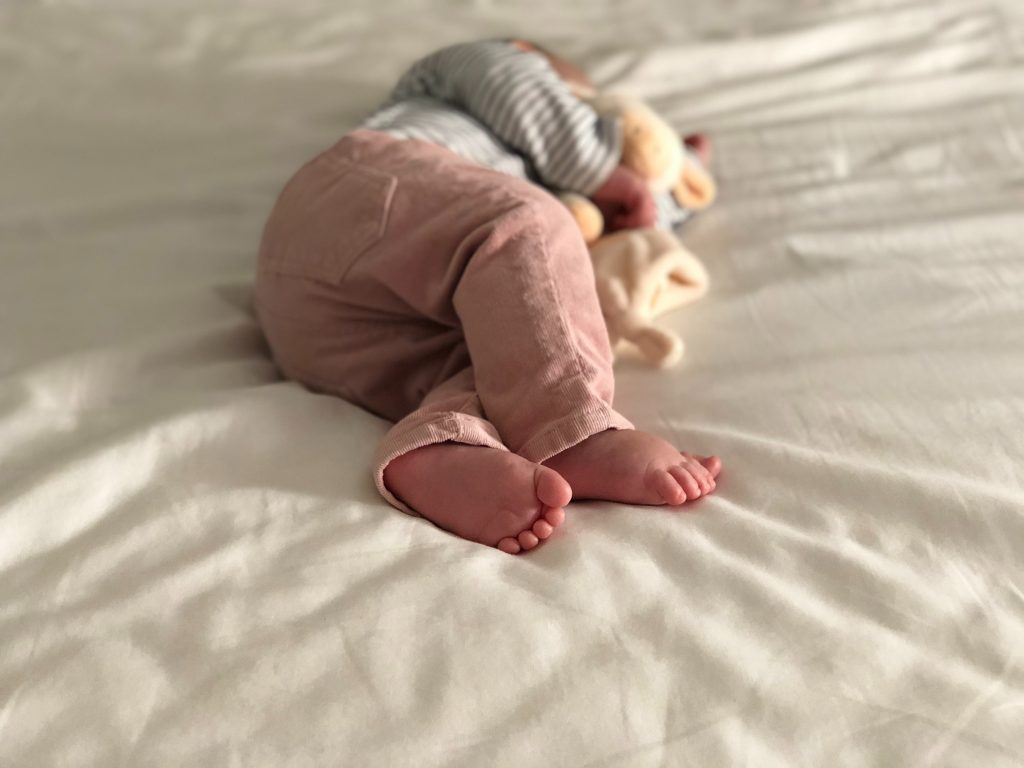If your child can’t sleep due to hip, knee, or thigh pain, it might be hip dysplasia (DDH). It’s a rare condition that affects newborns and children as they grow. If that’s the case, there are things you can do to help your child develop safely.

The first step to combatting the possibility of this condition is ensuring your child sleeps well. Not getting enough sleep due to hip pain may only worsen your child’s condition. In this article, you’ll learn more about hip dysplasia, as well as how to improve sleep for a child with hip pain.
What Is Hip Dysplasia in Children?
The two primary components of the hip are the ball and the socket. Together, they support walking, standing, and moving. As the child grows, the cartilage of the ball and socket solidify into a joint.
The slightest dislocation could lead to the child having hip pain. Furthermore, the socket might be shallow, meaning the ball won’t fit properly. The ball might also dislocate due to falling. As a result, the child will experience hip pain.
If that’s the case, you may want to fix the problem early on before it becomes a lifetime disability. Hip dysplasia could develop into arthritis. Unfortunately, DDH is very difficult to predict.
Causes of Hip Dysplasia in Children
Surprisingly, the root cause of DDH is unknown. While it might be hereditary, it might also be due to delivering the child in the breech position. Also, DDH is more common in firstborn babies and more prevalent in girls. Other causes of hip pain include driving accidents, infection, or osteonecrosis.
It’ll be easier to improve a child’s sleep with hip pain if you already know the cause. If you don’t, you might need help from a pediatric orthopedic specialist. You can also try the following home remedies to relieve hip pain.
Home Remedies for Hip Pain in Children
One home remedy for hip pain is feeding your child a banana before bed. Bananas are thought to regulate sleep hormones and relax muscle cramps. Here are other noninvasive ways to improve sleep for a child with hip pain:
-
Supplements
Supplements rich in D3 and K2 vitamins will help children absorb more calcium from their food and strengthen their cartilage. Some calcium supplements come in tasty gummies, so children will love taking them.
-
Hip Abduction Exercises
So long as it isn’t painful for the child, you could have them try hip abduction exercises. If their hip pain is due to weakness, these activities will strengthen their muscles. Within weeks, your child could be up and running thanks to these exercises. In addition, encourage your child to stretch frequently. You may also choose to introduce your child to Tai Chi, which is another great way to strengthen their hips and muscles.
-
Specialized Clothes
There are specialized baby clothes for infants with hip dysplasia. These clothes help keep a young one’s hip joints in place, regardless of whether you’re carrying them or they’re lying down. However, note that these clothes don’t work instantly. It can take up to four weeks before your infant will begin showing signs of improvement.
How to Determine if Your Child Has Hip Dysplasia
As we mentioned, DDH can be difficult to predict. More often than not, DDH manifests before there are any physical signs. In addition, DDH is oftentimes invisible to x-ray scans because cartilage isn’t as dense as bones. However, here is a list of some visible signs to look out for in your child:
- Their one leg is shorter than the other
- The skin on their thighs sags
- Prefers walking on their toes
- Limping
- Waddling
Treating hip pain must start as early as possible to avoid further complications. As we mentioned, you can use supplements, exercises, or specialized clothing and equipment. In addition, consider upgrading your child’s mattress to a memory mattress one.
Memory foam mattresses will allow your child’s hips to develop naturally. When sleeping on a memory foam mattress, their hips will “lock in place.” Moreover, memory foam mattresses will conform to your child’s body, preventing additional pressure. By switching to a memory foam mattress, you can relieve your child’s hip pain and potentially reverse any damage.
If a mattress upgrade isn’t an option, you can find out more about mattress toppers for hip pain. It’s a viable substitute that serves the same purpose. Plus, it can be instrumental in relocating the hip joint and helping the child recover while sleeping.
Conclusion
Hip dysplasia is a rare condition that affects children of all ages. It’s not always easy to spot because it develops before showing any physical symptoms. However, hip pain might be one of its most visible signs. If your child complains about hip pain, you should look into it.
If you act on it now, you might save your child a lot of frustration in the future. Your child will need all the support to thrive in their developmental stages. Don’t gamble with your child’s development if you’re not sure. Listen to their complaints and act accordingly. Not doing so could result in chronic pain.
















Add Your Comment